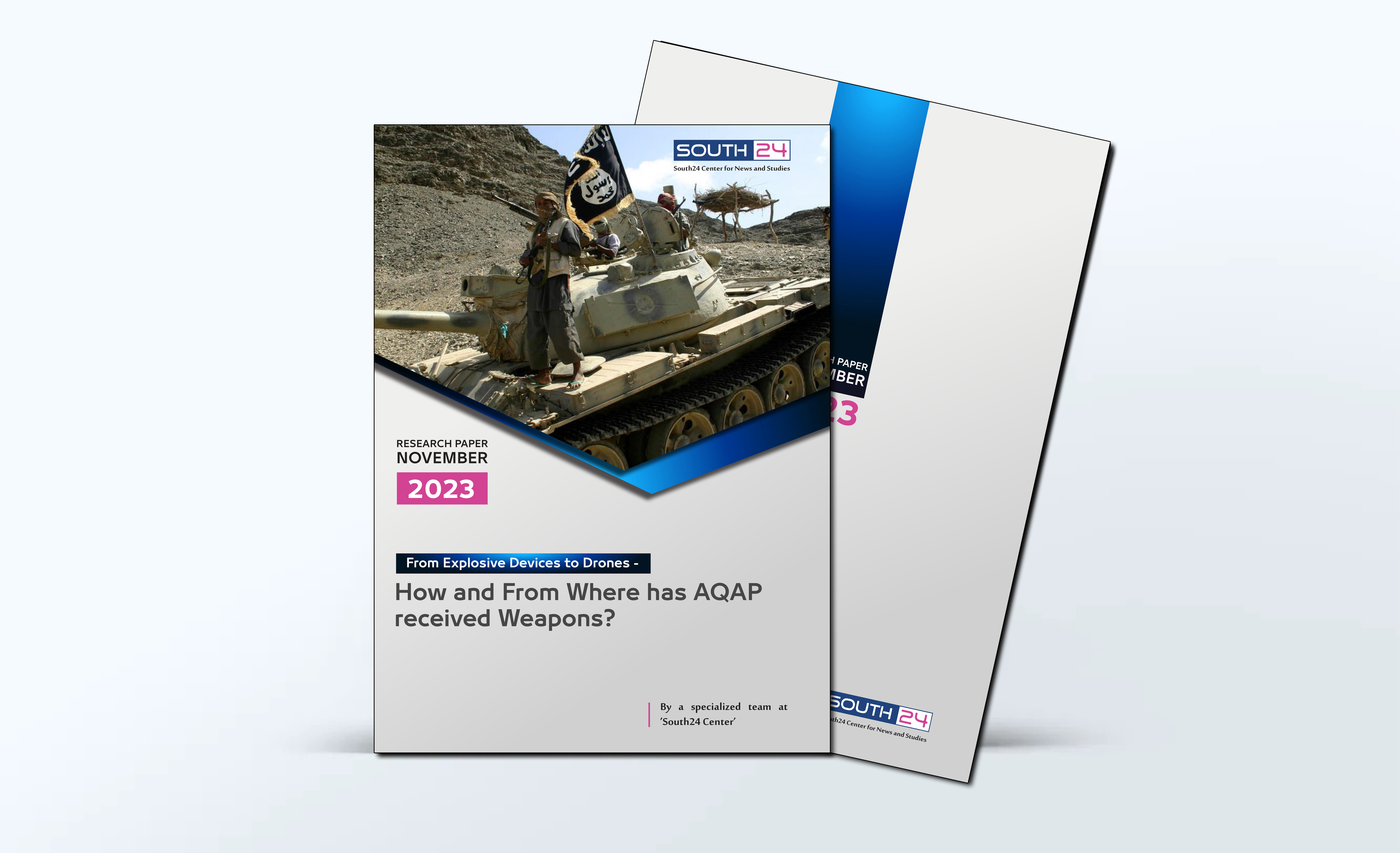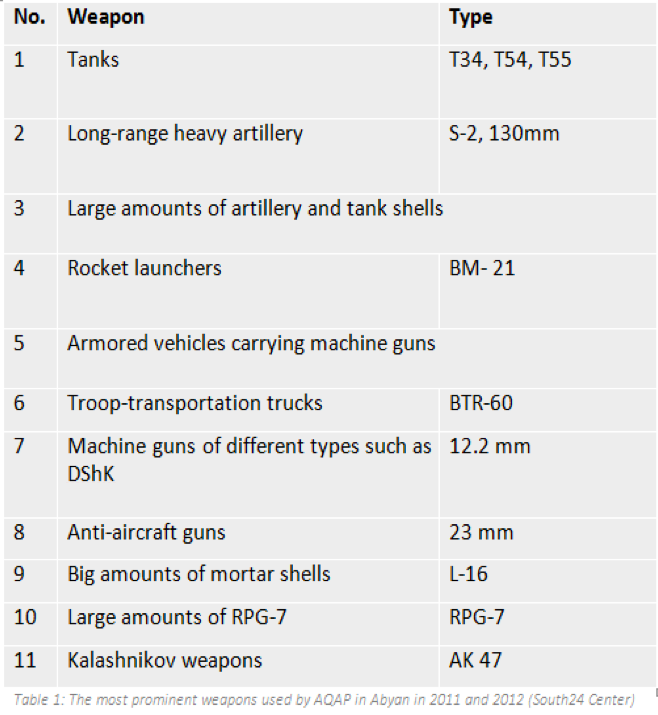
Photo by South24 Center
آخر تحديث في: 28-11-2023 الساعة 5 مساءً بتوقيت عدن
The paper points to the period when the Houthis were expelled from Aden and South Yemen after the Southern forces managed to turn themselves into well-trained and professional forces. They began the war against AQAP, with direct support from the UAE.
Aden (South24)
A research paper, issued by ‘South24 Center’, discusses the weapons owned by Al-Qaeda in Yemen, known as ‘Al-Qaeda in the Arabian Peninsula’ (AQAP). This is in light of the latest security development, as seen in the AQAP’s use of drones against the Southern forces in Shabwa Governorate.
The paper, originally written in Arabic, was prepared by a team specializing in armed groups and counterterrorism affairs. It consists of 23 pages and includes accurate details about AQAP’s stock of weapons. At one point, this arsenal included rocket launchers, shoulder-fired missiles, anti-aircraft artillery, various machine guns and military vehicles.
The Introduction section reviews the evolution of AQAP’s weaponry in a chronological manner. The use of explosive devices has been very much part of the organization before and after its establishment in 2009. The list includes explosive belts, machine guns, and even car bombs that were heavily used by AQAP in 2012 in Aden, Hadramout, Al-Bayda, Shabwa, and Sanaa.
The paper indicates that AQAP received some cannons and mortars during the same period from tribal leaders in Marib. Additionally, the organization seized a massive amount of heavy weapons from the Yemeni army’s camps in Abyan and Shabwa in 2011 and 2012. The paper has published the names and types of some of the weapons, as seen in the following table:

The paper has augmented its detailed explanation by providing photos of tanks and military vehicles obtained by the group at that time.
It discusses the 2015 War in which AQAP tried to go along with the Popular Resistance’s groups coming from Sanaa that opposed the Houthi and Saleh groups (those owing allegiance to former president Ali Abdullah Saleh). The paper said that the AQAP in Aden at the time seized some of the weapons sent by the Arab Coalition to the resistance.
The paper points to the period when the Houthis were expelled from Aden and South Yemen after the Southern forces managed to arrange their ranks and turned into well-trained and professional forces. They began the war against AQAP, with direct support from the UAE, especially in the governorates of Aden, Lahj, Abyan, Shabwa and Hadramout.
According to the paper, in 2019 and 2020, AQAP participated on the side of forces that were mostly affiliated with the Islah Party, in Abyan against the Southern forces. Shabwa served as a safe haven for AQAP after it left Al-Bayda in 2021.
During that period, the organization accessed part of the weapons and support allocated for the forces that sought to invade Aden, the headquarters of the Southern Transitional Council (STC).
The paper also makes a thorough evaluation of the latest buildup in AQAP's arsenal, especially their procurement of weaponized drones and using them several times, basically against the Shabwa Defense Forces (aligned with the STC) in Al-Masaniah in Al-Said District. The paper suggests three possible sources of obtaining the drones: local manufacturing, the Houthi militia, or forces affiliated with the Islamic Islah Party.
It describes the first source as a weak possibility, though not impossible. It says the second source is the most likely one. The paper mentions objective reasons that may push the Houthis to provide their supposed rival, the AQAP, with drones, including creating pretexts to resume the military assault against South Yemen and distracting the STC.
The paper has pointed to evidence that enhances this possibility, including confessions by AQAP members who were arrested by the Shabwa Defense Forces. In addition, the Al-Qaeda is experiencing an internal transformation, represented in the rise of Saif al-Adel as a leader of the organization following the death of Ayman al-Zawahiri in July 2022. Al-Adel is believed to be living in Iran and coordinates with AQAP.
However, the paper doesn’t exclude a possible third source -“former weapon companions”, in a reference to the government forces affiliated with the Islah Party who were driven out of Abyan and Shabwa by the Southern forces in 2021. They probably tried to compensate for their losses by arming AQAP with these dangerous capabilities.
The paper strongly warns about the threat posed by AQAP’s new weapons (the drones) which goes beyond the local level, and extends to the regional and international sphere. The research paper reminds that the Iran-backed Houthis have hit Saudi Arabia, the UAE, and Israel recently with drones and they threaten international navigation in the Red Sea and the Bab Al-Mandab Strait.
Recommendations:
● AQAP’s use of any type of drones is a dangerous development which requires constant efforts to learn more details about its sources as part of the international counterterrorism war.
● The drones are part of the different weapons acquired by AQAP, and effortlessly, from certain local or external parties over the past years. This needs serious investigation to identify their sources.
● AQAP’s ability to acquire this weapon should raise the alert, regardless of its use. The acquisition is related to the organization’s operational policy rather than the availability of the weapon.
● AQAP’s acquisition of this kind of weapon should push the US Administration to reconsider its dwindling interest in the counterterrorism file in Yemen.
● AQAP’s possession of drones requires an immediate international move so that it does not turn into a threat against international navigation in the Red Sea. The use of drones also expands the AQAP’s regional and international threats.
● Counterterrorism efforts by the Southern forces affiliated with STC in South Yemen should be enhanced with logistic and intelligence support, as well as by tracking the sources of weapons and the networks involved in AQAP’s selling and smuggling operations.
● Strict and deterrent legal measures should be taken against the groups that supply or help in delivering these weapons to AQAP at both local and regional levels. This includes the Houthis, the Islah Party, and the tribal figures whose involvement is proven.
● Efforts by the Yemeni coast guards should be consolidated in the Red Sea, the Bab Al-Mandab Strait, the Gulf of Aden, and the coasts of Al-Mahra that borders Oman.

قبل 3 أشهر